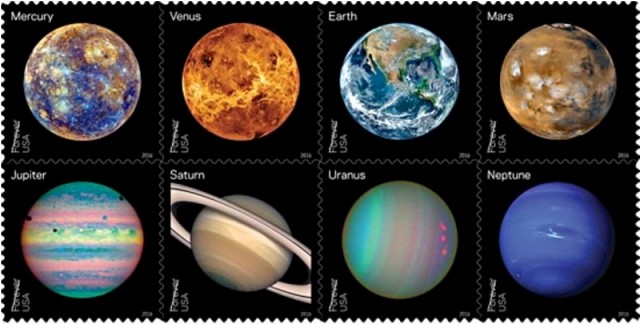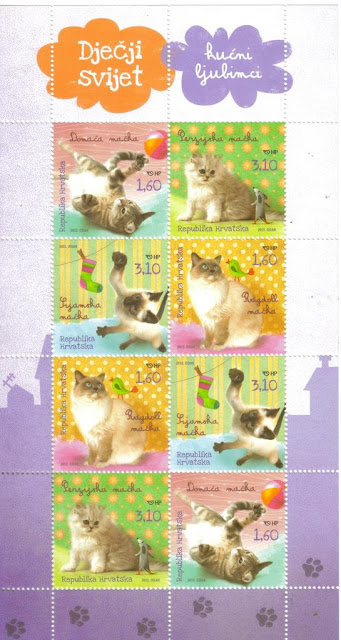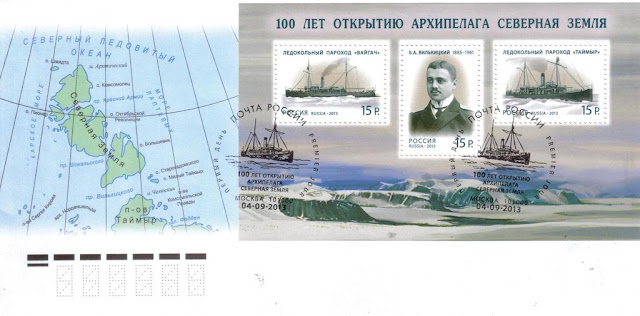So I can say that I surely have a lot of lighthouse-related stamps which kinda made it a bit difficult to make my choice today, but I think you won't be disappointed with these two amazing sheets of stamps coming from Ukraine.
The first one was issued in 2009 and contains 6 different Ukrainian lighthouses, from left to right you can see:
- the Kyz-Aulskyi lighthouse - located on the point of the Cape, South-East of Yakovenkove and helps guide ship(s) to the entrance of the Kerch Strait. The Lighthouse is in the diamond shaped peninsula of Crimea and is one of the Black Sea Lighthouse(s) in Ukraine. It is 28 metres tall and has a white, red, or green colour scheme (depending on the direction) with a flash of every 6 seconds.
- the Luparevskiy Lighthouse - located on the East coast, the south side of Luparevo. This Lighthouse is the second range for vessels bound upstream (North) in the estuary. The Lighthouse is in the Mykolaiv Area of Ukraine. It is 10 metres tall and has a white red colour scheme of continuous flash.
- the Yaltinskiy Lighthouse - located at the end of the Yalta breakwater, which extends South-Westward parallel to the shoreline. The Lighthouse is one of the best-known Lighthouse(s) in Crimea. The Lighthouse is in the diamond shaped peninsula of Crimea and is one of the Yalta Lighthouse(s) in Ukraine. It is 12 metres tall and has a red light colour scheme of 3 seconds on/4.5 seconds off.
- the Vorontsov Lighthouse is a famous red-and-white, 27.2 metre landmark (with a scheme of 3 flashes every 12 seconds) in the Black Sea port of Odessa, Ukraine. It is named after Prince Mikhail Semyonovich Vorontsov, one of the governors-general of the Odessa region. The Lighthouse is accessible only by boat.
- the Sarych Lighthouse - located at the Southernmost point of the Crimean peninsula as well as Ukraine and South-East of Sevastopol. It is 15 metres tall and has a white light colour scheme of 3 seconds on/3 seconds off.
- the Berdyansk Nizhniy Lighthouse - located at the end of a long, hook-shaped spit South of Berdyansk. The Ukrainian coast features four long sand spits projecting to the South. The Lighthouse is in the area of Sea of Azov, connected to the rest of the Black Sea by a very narrow Kerch Strait. The Lighthouse is accessible by boat. It is 22 metres tall and has a white colour scheme of 4.5 seconds on/3 seconds off.
Each of the stamps from this issue has a face value of 1.50 UAH.
The second sheet was issued in 2010 and again consists of 6 stamps (with a slight face value difference - there are 3 stamps of 1.50 UAH and 3 stamps of 2 UAH). And another difference is that I couldn't find nearly as much information as for the previous one.
Anyways, the lighthouses featured are as follows:
- the Sanzhyisky lighthouse - located North-East of the mouth of the Dnister and South-West of Odessa. The Sanzhiiskyi is one of the South Coast Lighthouse in Ukraine. Its height is 19 metres with a green colour scheme of two flashes every 15 seconds.
- the Tendrivskiy lighthouse
- the Tarkhankut lighthouse - located in Crimea at the Tarkhankut Cape 5 km southwest of the resort village of Olenivka. Its height is about 40 metres. The construction of the Tarkhankut lighthouse and its twin tower on the Khersones peninsula started in 1816 to ensure safe sailing in the area.
- the Pavlovskiy Front lighthouse, located in Crimea, station established 1863. Active; focal plane 65 m; continuous red light. 17 m octagonal stone tower, painted white with a red vertical stripe on the range line. This light replaced the original lighthouse, which had a focal plane of 22 m. Located about 500 m from the waterfront in Arsyncevo, about 6 km south of Kerch city.
- the Illichivskyi lighthouse -located in a small town called formerly Illichivsk, nowadays Chornomorsk, located south of Odessa on the Black Sea.
- the Khersoneskyi lighthouse - station established 1816. Active; focal plane 34 m; white light, 3 s on, 3 s off, 3 s on, 3 s off, 3 s on, 6 s off, 3 s on, 3 s off, 6 s on, 3 s off, 6 s on, 18 s off. 36 m round stone tower with lantern and gallery, painted white. This historic lighthouse stands on the southwest corner of the Crimean peninsula. The original lighthouse was a conical stone tower. It was replaced in 1929 by a lighthouse built from the same plans as the Tarkhankut Light. Almost completely destroyed during World War II, it was replaced by a wood tripod tower until a copy of the 1929 lighthouse could be built. The tower is greatly endangered by rising sea level, and a stone berm and semicircular sea wall have been built to protect it. The unusual flash pattern, the Morse code "SW" for Sevastopol', is a traditional welcome-home for Russian sailors. Located at the tip of the peninsula about 15 km west of Sevastopol'.
So that would be my contribution for today. Can hardly wait (and be jealous of!) other people's collections of lighthouse stamps :) You can see them at today's Sunday Stamps episode.














